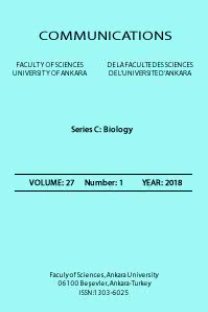CHEMICAL COMPOSITION AND ANTIOXIDANT ACTIVITY OF SEVEN DIFFERENT GRAPE EXTRACTS
Grape, extraction, qualitative characterization, radical scavenging activity
___
P. Suppakul, J. Miltz, K. Sonneveld and S.W. Bigger, Antimicrobial properties of basil and its possible application in food packaging. Journal of Agricultural and Food Chemistry, 51, (2003) 3197–3207.R. Mickiene, B. Bakutis and V. Baliukoniene, Antimicrobial activity of two essential oils. Annals of Agricultural and Environmental Medicine, 18 (1), (2011) 139-44.
M.F. Balandrin, J.A. Klocke, E.S. Wurtele, W.H. Bollinger, Natural plant chemicals: sources of industrial and medicinal materials. Science, 228, (1985) 1154–1160.
M.J. Tuorkey, Cancer therapy with phytochemicals: present and future perspectives. Biomedical and Environmental Sciences, 28, (2015) 808–819.
F. Conforti, G. Ioele, G.A. Statti, et al Antiproliferative activity against human tumor cell lines and toxicity test on Mediterranean dietary plants. Food and Chemical Toxicology, 46, (2008) 3325–3332.
B. Dzhambazov, S. Daskalova, A. Monteva, and N. Popov, In vitro screening for antitumour activity of Clinopodium vulgare L.(Lamiaceae) extracts. Biological and Pharmaceutical Bulletin, 25, (2002) 499–504.
S. Bail, G. Stuebiger, S. Krist, H.Unterweger, and G.Buchbauer, Characterisation of various grape seed oils by volatile compounds, triacylglycerol composition, total phenols and antioxidant capacity. Food Chemistry, 108, (2008) 1122–1132.
C. Pérez, M.L.R. del Castillo, C. Gil, G.P. Blanch, and G. Flores, Supercritical fluid extraction of grape seeds: extract chemical composition, antioxidant activity and inhibition of nitrite production in LPS-stimulated Raw 264.7 cells. Food & Function, 6, (2015) 2607–2613.
H. Atmaca, E. Bozkurt, M. Cittan, and H. Dilek Tepe, Effects of Galium aparine extract on the cell viability, cell cycle and cell death in breast cancer cell lines. Journal of Ethnopharmacology,186, (2016) 305–310.
O.P. Sharma and T.K. Bhat, DPPH antioxidant assay revisited. Food Chemistry, 113, (2009) 1202–1205.
P. Iacopini, M. Baldi, P. Storchi and L. Sebastiani, Catechin, epicatechin, quercetin, rutin and resveratrol in red grape: Content, in vitro antioxidant activity and interactions. Journal of Food Composition and Analysis, 21, (2008) 589–598.
V.M. Burin, N.E. Ferreira-Lima, C.P. Panceri and M.T. Bordignon-Luiz Bioactive compounds and antioxidant activity of Vitis vinifera and Vitis labrusca grapes: Evaluation of different extraction methods. Microchemical Journal,114, (2014) 155–163.
E.A. Hayouni, M. Abedrabba, M. Bouix and M. Hamdi The effects of solvents and extraction method on the phenolic contents and biological activities in vitro of Tunisian Quercus coccifera L. and Juniperus phoenicea L. fruit extracts. Food Chemistry, 105, (2007) 1126–1134 .
N.S. Kelley, N.E. Hubbard and K.L. Erickson, Conjugated linoleic acid isomers and cancer. The Journal of Nutrition, 137, (2007) 2599–2607.
- ISSN: 1303-6025
- Yayın Aralığı: Yılda 2 Sayı
- Başlangıç: 1943
- Yayıncı: Ankara Üniversitesi
FRAXINUS L. POLLEN DYNAMICS IN ANKARA ATMOSPHERE
Aydan ACAR ŞAHİN, Nur Münevver PINAR
POLLEN MORPHOLOGY OF GYPSOPHILA LARICINA L. AND TAXONOMIC IMPORTANCE
İsmühan POTOĞLU ERKARA, Mustafa UYANOĞLU
ANTIOXIDANT AND PHYSICOCHEMICAL PROPERTIES OF CHESTNUT HONEYS FROM TURKEY
ANTIMICROBIAL ACTIVITIES OF SOME BRYOPHYTES IN TURKEY
Şenol ALAN, Ferudun KOÇER, Güray UYAR
COMPARISON OF TWO AEROBIOLOGICAL STATIONS DATA IN ZONGULDAK
FLORA AND HABITAT DIVERSITY OF KAVUNCU SALTMARSH
G. Nilhan TUG, A. Emre YAPRAK, S. Tuğrul KORUKLU, Ümit BINGOL
BEE POLLEN AND ITS PHARMACOLOGICAL PROPERTIES
SPORE MORPHOLOGY, TAXONOMICAL AND ECOLOGICAL IMPORTANCE OF BRYOPHYTA FROM TURKEY
İsmühan POTOĞLU ERKARA, Filiz BIRGI, Onur KOYUNCU
THE ALLERGENIC POLLEN IN THE ATMOSPHERE OF EL-HADJAR CITY (ANNABA, ALGERIA)
AN INVESTIGATION OF POLLEN GRAIN THERMAL DIVERSITY ON SPECIES LEVEL
